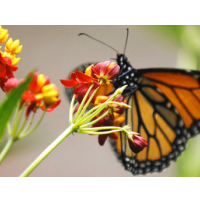EPA Sued over Not Protecting Decimated Monarch Butterflies from Monsanto
 Monarch butterfly feeding on a milkweed plant (photo: Steve Smedley, Pantagraph via Associated Press)
Monarch butterfly feeding on a milkweed plant (photo: Steve Smedley, Pantagraph via Associated Press)
The monarch butterfly population has plummeted in less than 20 years—as coastal Californians can attest—leading one environmental group to sue the U.S. Environmental Protection Agency (EPA) to take action.
The Natural Resources Defense Council (NRDC) filed suit in a New York City federal court seeking an order to force the EPA to review an emergency petition that it filed last year. The NRDC claims the EPA never responded to the request.
The group also wants the agency to review within six months its rules governing glyphosate, the main ingredient in Monsanto’s Roundup, a commonly used herbicide that has wiped out the milkweed plant in many parts of the country. Monarch butterflies rely on the milkweed for their survival.
The monarch population has dwindled from 1 billion in 1997 to 56.5 million this winter—a drop of 90%, according to the complaint (pdf). The decline coincided with the growing popularity of glyphosate, which was used on 90% of corn and soy fields in the U.S. in 2011.
Monarchs, with their distinctive orange and black wing patterns, spend a lot of time in California. They pass through during migration between the forests of central Mexico and southern Canada, and also overwinter in the state. They migrate north in the spring and south in the winter, chomping down on milkweed as caterpillars and often extending their stay in the state. Most monarchs migrating west of the Rockies can be found in more than 200 groves along the California coast.
The winter population of monarchs in California is more difficult to track than in Mexico because the butterflies are more spread out in smaller groupings. Every year, volunteers participate in the Western Monarch Thanksgiving Count and in 2013-14 found 211,275 at 162 sites. That was consistent with findings in the previous decade, from a low of 58,000 in 2009-10 to a high of 254,000 in 2003-04.
But it was a far cry from 1997-98’s total of 1.2 million. The next year it plummeted to 564,000.
The NRDC says the “distinctive butterfly” is “in peril,” and faces the risk of completely dying off. “The remaining population is so small that a single severe weather event could eradicate it,” the group wrote. “Scientists have warned that the monarch migration is at risk of vanishing.
“In 2002, a single snowstorm on the Mexican wintering grounds killed more monarchs than currently comprise the entire population,” the complaint states. “The continued loss of butterflies will make this already imperiled population increasingly vulnerable.”
Use of Roundup has increased as Monsanto has developed and promoted “Roundup-Ready” crops that are resistant to the herbicide. However, farmers using the chemical are killing neighboring milkweed plants on which monarchs thrive.
–Noel Brinkerhoff and Ken Broder
To Learn More:
Environmentalists Link Plunge of Monarch Butterfly to Herbicide (by Lorraine Bailey, Courthouse News Service)
Mexico Monarch Butterfly Decline Fans Fears in California (by Peter Fimrite, San Francisco Chronicle)
2013-14 California Overwintering Population Numbers Released (Monarch Joint Venture)
For the Monarch Butterfly, a Long Road Back (by Liza Gross, New York Times)
Natural Resources Defense Council v. U.S. Environmental Protection Agency (U.S. District Court, Southern New York) (pdf)
Public-Private Partnership Tries to Save Monarch Butterflies as Population Collapses by 970 Million in 25 Years (by Noel Brinkerhoff and Steve Straehley, AllGov)
- Top Stories
- Controversies
- Where is the Money Going?
- California and the Nation
- Appointments and Resignations
- Unusual News
- Latest News
- California Forbids U.S. Immigration Agents from Pretending to be Police
- California Lawmakers Urged to Strip “Self-Dealing” Tax Board of Its Duties
- Big Oil’s Grip on California
- Santa Cruz Police See Homeland Security Betrayal in Use of Gang Roundup as Cover for Immigration Raid
- Oil Companies Face Deadline to Stop Polluting California Groundwater





